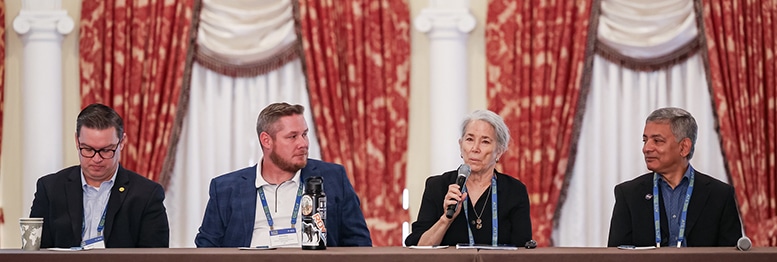Urban air mobility (UAM) is moving into a new phase thanks to technological advances and the Federal Aviation Administration (FAA) issuing a final rule on October 22 about the qualifications and training for pilots and instructors.

2025 could be the year that advanced air mobility vehicles — which take off and land vertically and cruise like an airplane — fly in U.S. cities, according to aviation industry leaders who spoke during a panel at the Advanced Technological Education (ATE) Principal Investigators’ Conference on October 24.
Billy Nolen, chief regulatory officer of Archer Aviation, moderated the panel that included David Oord, policy manager of Wisk Aero LLC. Archer is developing a vehicle operated by a pilot that will carry up to four passengers 50 miles. Wisk is working on four-seat autonomous air taxis that operate along specific commuter routes. Both companies’ vehicles use high-voltage, electric batteries.
Among the yet-to-be-resolved issues regarding UAM vehicles are the standards for maintaining them and how students and incumbent technicians not currently affiliated with the manufacturers will learn about UAMs. It is expected that repairs will need to be done locally and quickly.
“To make the business case you have to fly them as much as possible,” said Koushik Datta, university innovation project manager at the National Aeronautics and Space Administration (NASA). The FAA is the lead federal agency that will regulate all aspects of these new vehicles, but NASA is among the agencies weighing in on the regulations that are being developed.
“I think there are a lot of challenges … It’s going to take a lot of us working together,” Datta said.

The task of figuring out how to educate the aviation maintenance workforce for UAM vehicles is an opportunity for community and technical colleges that could seek support from the National Science Foundation’s ATE program.
“This absolutely fits within ATE,” V. Celeste Carter, the lead ATE program director at NSF, said during the panel discussion.
Three ATE centers and numerous projects already work in fields that have the potential to overlap with UAMs.
Zackary Nicklin, director of aviation maintenance at St. Cloud Technical College (Minnesota) and co-principal investigator of the National Center for Autonomous Technologies, explained that last summer he led a team of educators through a process that extracted key points from the standards another ATE project developed for electric automotive vehicles to identify a core skill set for UAMs.
He hopes that by adding information to the existing aviation maintenance curriculum, it will help “produce maintainers that are more ready to jump into those roles and minimize the training that the industry itself has to do.”
He pointed out that community colleges have been educating aviation maintenance technicians for decades.
“That’s kind of our baby. So, if we can maximize the outcomes for a student as they come through our programs, maximize the knowledge to work, not just of aviation of the last 30 years, of the last 50 years, but for the next 30 years and set them up for success, that’s what we’re trying to do,” Nicklin said.
Educators and industry representatives also discussed the use of extended reality (XR) technologies to teach about UAMs at a point when the vehicles are too expensive for colleges to buy for training and companies have proprietary equipment.
Another ATE-supported center, the Center for Aviation and Automotive Technological Education Using Virtual E-Schools at Clemson University, has been creating instructional virtual reality simulations since 2012. But an audience member at the session observed that some faculty are reluctant to use simulations because that was not how they learned.

Nolen said when he began as an airline pilot decades ago, there was a reliance on paperwork flows, so he understood “that hesitancy to really embrace technology.” But, he said, “We are truly talking about the future. That used to be the future, but it is here now and all the associated technologies go along with that.”
All the speakers emphasized that safe operations are the priority. But the desire for the U.S. to be a leader in urban air mobility is also a driver.
Datta put it this way: “We hope as a government agency altogether that we can support this market. We have to support them. We have to let them become the first in the world to get to market. As a person in the government, I really want to make sure that the U.S. is the first in the market and the biggest market because it’s really important for us in the future.”

